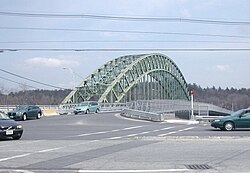Tyngsborough Bridge | |
|---|---|
 The arch bridge in Tyngsborough, Massachusetts, with the Temporary bridge alongside it in 2006 | |
| Coordinates | 42°40′34″N71°25′17″W / 42.67605°N 71.42133°W |
| Crosses | Merrimack River |
| Locale | Tyngsborough, Massachusetts |
| Official name | Tyngsborough Bridge |
| Owner | Massachusetts Highway Department |
| Preceded by | Whipple Truss Bridge |
| Characteristics | |
| Design | Tied-arch bridge |
| Material | Steel |
| Total length | 656 feet (200 m) |
| Width | 41.5 feet (12.6 m) |
| Longest span | 547 feet (167 m) |
| No. of spans | 1 |
| Piers in water | 0 |
| Load limit | M 18 |
| History | |
| Designer | MassHighway in-house Design Unit |
| Constructed by | Simpson Bros. Corporation [1] Boston Bridge Works [2] |
| Opened | 1930 |
| Rebuilt | 1975 |
| Statistics | |
| Daily traffic | 22,300 (2007) |
| Location | |
 Interactive map of Tyngsborough Bridge | |
The Tyngsborough Bridge is a steel tied-arch bridge located in Tyngsborough, Massachusetts and carries Route 113 over the Merrimack River. With a span of 547 feet, it has the longest span of any steel rib through arch bridges in Massachusetts. It is also the 2nd oldest steel rib through arch bridge in the state. The bridge is center hinged and features pratt-type trussing. [3] [4]
